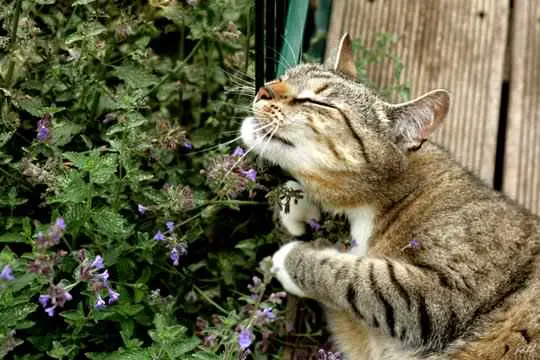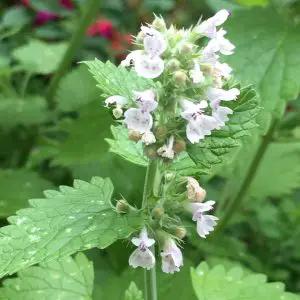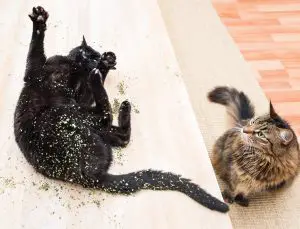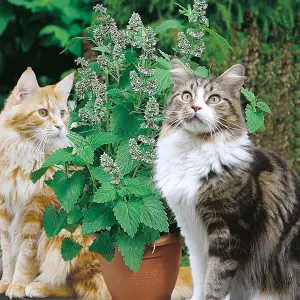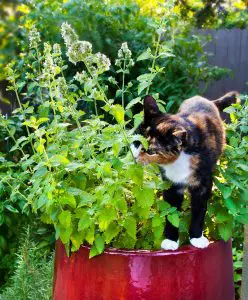What is catnip? Chances are that you have read or heard about catnip and how cats react to it, especially if you are a cat owner. The effect of catnip on cats is one of those bizarre discoveries that humans made through our interaction with plants and domestic animals. For those who have never heard about catnip before now, it is a plant that belongs to the mint family and releases a volatile chemical that cats are crazy about.
This article focuses on the important things that you need to know about catnip, including information about the plant, where it can be found naturally, how it effects your cat and above all is it safe to use.
What is catnip?
What is catnip? Catnip has a long list of names that it is called, and this may differ based on region or culture; catmint, kitty crack, field balms, catmint, are just some of the names that the plant is called. But whichever you choose to call it, it has a very unique effect on cats, whether domestic or wild.
Catnip is a plant that belongs to the Nepeta genus, a type of mint that produces a variety of volatile chemicals and oils. Catnip does not have a noticeable effect on humans as it does on cats;to humans, it is just a sweet smelling plant.
The lemony, minty Nepeta Cataria has been associated with cats for ages. This explains why its Latin-derived name cataria translates to “of cats”. Several scientific researchers have proven that cats are extremely fond of catnip, and will exhibit a kind of “high” when sniffed or chewed upon.
The psychoactive effect of catnip in cats can be likened to when a human gets high off marijuana or substances like LSD.
What does catnip look like?
Catnip is a perennial plant that will thrive vigorously in most conditions and grows just like a weed; it can sometimes grow as tall as three feet with heart-shaped leaves. There are sprouts of small blue, white, lavender or pink on the tips of the stem. The plant has a characteristic square stem which is an attribute of the mint family and is easily identified in small bushes. They are not usually grown for ornamental purposes in home gardens like Nepeta x faassenii and other plants grown for such purposes.
Where is catnip found naturally?
Catnip is a weedy plant that thrives in almost every climate from Africa to Asia, but the origin of the herbaceous perennial plant can be traced to the Eurasia region. Nepeta cateria occurs naturally throughout the temperate regions across the world and is usually found in areas with noticeable disturbances such as edges of grass fields, roadsides, on waste grounds and along streams.
Catnips do not need any special treatment as they are very hardy but short-lived. However, you might want to pinch them in order to make them grow in more defined and less “weedy” manner. Because catnips thrive really well, you are likely to find them in the homes of cat lovers, they can be grown as an indoor plant but they must be positioned where they can get a good amount of sunlight. The window makes a good spot for a catnip plant.
Catnip will grow pretty well in different types of soil, even in well-drained soils. Although, the plant prefers slightly alkaline soils but is not really sensitive to the type of ground in which they grow as long as their roots are not always wet or sitting in waterlogged soil. This is one of the major reasons why the plant is successful in different regions of the world.
Catnip (Nepeta cataria) is naturally found in Northern America, but this wasn’t always the case as the plant was transported to the continent by settlers. Today, the plant has become a very popular herb garden plant in North America, thriving in many areas as a cultivated garden herb and also freely like any other weed.
Catnip is also widely naturalized in Central Asia, New Zealand, the Middle East, as well parts of Africa.
What effect does catnip have on your cat and how does it do it?
It is quite understandable why anyone would find catnip’s effect on cats bizarre, it is the only known recreational drug that is given to cats which can make them act a little crazy. For many years people have wondered how it is possible that cats behave a little strange when they sniff on catnip, well, the simple and straightforward answer to that is as simple as nepetalactone. This substance, whether it is from a dried plant or from a live one, or as an oil extract, is what makes your cats exhibit that “high”.
The process by which the chemical influences your cats’ behavior is quite simple, and we are going to dive into a little bit of biology (anatomy) in order to understand how nepetalactone works. The chemical locks on to the receptors located in the cat’s nose, which is responsible for stimulating the neurons which translate this information directly to the brain. All of this happens in a second from the moment the cat sniffs on the catnip.
Nepetalactone tends to alter activity in several regions of the brain including the amygdala, hypothalamus, and the olfactory bulb. The hypothalamus is the area of the brain that is responsible for regulating emotions, so it is quite clear why the chemical has such a remarkable impact on altering your cat’s behavior.
Researchers once hypothesized that nepetalactone may be responsible for triggering a certain reaction in an organ called the vomeronasal organ – considered to be an extra olfactory organ located in the deeper parts of the nose in a number of mammals (except humans), which primarily detects pheromones.
However, the hypothesis has been ruled out as a viable explanation for the effects of nepetalactone in cats. it is also hypothesized that the chemical could make nasal receptors mistake the chemical for pheromones, suggesting that the chemical could take the shape of pheromones in the process of locking on to the nasal receptors.
Now, whether these hypotheses turn out to be a fact, or not, one thing that we can know is true is that nepetalactone triggers behavior that is very intense, and makes your cat intoxicated.
If you are just learning about catnip for the first time, you can experiment by putting some catnip on your cats scratching board – keep a close watch as your cat sniffs it, and almost immediately, your cat will begin to rub its face on the board and roll on the catnip, you might even notice drooling.
“They seem to have a sense of euphoria when they’re doing all this, and then afterward, calmness. Once they’re finished reacting, and they just sit there, it’s like they’re basically just a little bit buzzed.” For about 30 minutes afterward, they sit there in a stupor, seemingly immune to being further affected by more catnip.” Says veterinarian Jeff Grognet– who has published several articles about the effects of catnip on cats.
Nepetalactone is not the only chemical that influences this sort of reaction in cats. Other chemicals include iridomyrmecin and actinidine- both chemicals are naturally occurring in various plants.
Grognet says one interesting thing about the effect the chemical has on cats is that even though it presents itself like an uncontrollable and frenzied high experienced when a human uses a hard drug, it is quite different in cats. “Catnip produces a very definite, repeatable response. A cat will pretty much do the exact same thing every time it smells it” he adds. “The cat isn’t rubbing their face and rolling in the catnip to get more of it (as I’d assumed), but simply because getting high by inhaling the catnip compels them to do so.”
Another major difference between the effect of catnip on cats and the effect of drugs on humans is that only 70 to 80{fcfd0acd12322060b34d46992510b83e8fc1fe033e8dfcd7aa5d0cb23e0cf6d4} of cats are affected by the chemical in the plant. As mentioned earlier in the post, this is a great indication that the trait may be passed on genetically from one generation to the next. “They either react, or they don’t,”. “There’s no in-between.” Grognet says. Many cat species of wild cats including tigers and lions are susceptible to react to catnip.
How long do catnip effects take to wear off?
The effect of catnip does not last long; it will only last for about 10 to 15 minutes on the average. Another interesting thing about the catnip phenomenon is that cats will not react to the plant if they are repeatedly exposed to it. They usually need about an hour or two before they can respond to the herb the same way as the previous time they were exposed to it
Do all cats react to catnip?
Catnip (Nepeta Cataria) contains a chemical compound, which is found in the stems and leaves of the plant and is responsible for attracting cats. Not all cats react to catnip. Experts in the field have estimated 50 to 75{fcfd0acd12322060b34d46992510b83e8fc1fe033e8dfcd7aa5d0cb23e0cf6d4} of cats are affected by the plant or display any form of reaction. One interesting discovery is that most cats in Australia do not react to catnip. This could be due to the fact that the sensitivity to nepetalactone is genetically transmitted.
Is catnip safe for cats to use?
To date, there have not been any findings that show the negative effect of catnip on cats. The plant is known to have a very temporary effect on cats even with long term use, but it is advised that catnips should not be given to cats to prevent habituation. As a matter of fact, catnip is beneficial to households with multiple cats; it has proven to play a very important role in keeping the peace among cats.
The plant is also known to be an effective method of training your cat. Catnip Is safe for your cat whether it sniffs on it or ingests it, however, we recommend a less frequent use. There several reports that suggest that cats will not respond to catnips if they have been exposed to the herb too frequently. There have also been reports of aggressive behavior if cats become overexposed to the herb. However, it is expected that there will be a slightly different reaction from cat to cat.
What other uses are there for catnip?
What is catnip, other uses? Even though humans do not react to the plant as cats do, catnip has found several purposes in everyday use; one very important use of catnips is as a mosquito repellant. The aromatic nature of the plant has proven over the ages to be a very strong insect repellant, and it remains a natural remedy for mosquitoes and other insects till this day.
In some cultures, catnips are used for medical purposes and as a remedy for fevers and colds.
Grow your own catnip.
Most people buy catnip in its dried and cut up form. This is usually available from your local pet store at a cheap price. However it can be much more fun and interesting to grow your own catnip plants.
As mentioned earlier in this post, catnip is a very hardy plant and grows easily and rapidly. This means that it can be grown in most climates and environments.
I personally use this kit from Amazon. It is easy to grow and my cats absolutely love the stuff.
I hope this guide to catnip has cleared up any questions you may have had.
